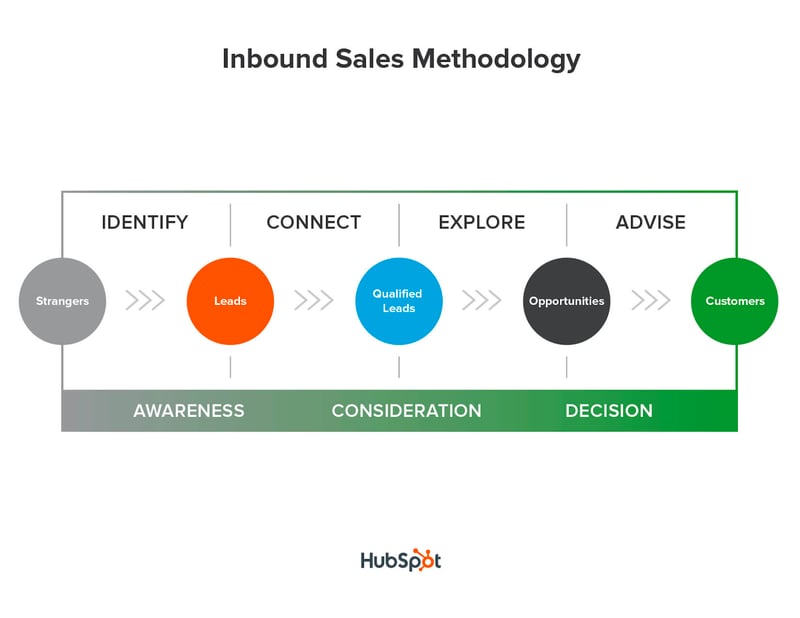
Inbound vs Outbound Sales for Modern Business: Comparison & Pro Tips
 Updated on
Updated on
 By Carlos Correa
By Carlos Correa
Carlos Correa
Carlos has been involved in the sales space for well over ten years. He began in the insurance space as an individual sales agent, managing teams as s...
learn more
Carlos Correa
Carlos has been involved in the sales space for well over ten years. He began in the insurance space as an individual sales agent, managing teams as s...
Table of Contents
Table of Contents
Struggling to decide between outbound and inbound sales?
It's not just that everyone has an opinion; it's that the opinions are strong, divided, and often conveniently siding with whatever that person is trying to sell you.
Not too helpful for you or your business.
But still, you have a budget to work with and important decisions to make, so you need to settle the age-old inbound vs outbound sales dilemma once and for all.
What are their benefits and drawbacks? What's the final verdict, and why? Do you really have to pick a corner?
All valid questions we're about to answer.
We're not just going to give you a one-size-fits-all solution.
By the end of this article, you'll be able to weigh out your options and discern the best route for your business.
Let's get ready to rumble! *
What is Inbound Sales
Inbound sales, in the simplest possible terms, is the tactic that sets the stage for and leads the prospect to initiate contact with your company and not the other way around.
Um, you mean a dream come true? How does this work?

This is the play-by-play:
- The prospect raises a question or pain point
- They start inhaling all kinds of content about it
- Your blog, video, etc., answers their questions, introduces them to your company, and immediately earns you "helpfulness" points
- They sign up for a consultation/your newsletter/otherwise give you their contact information – willingly because they're already primed for it and want more of your stuff
- You email or call them and it's not awkward or, well, cold
The inbound sales method operates by attracting the prospects who are already actively looking for the solution you're offering by giving them all the relevant and helpful information.
The Pros and Cons of Inbound Sales
These are the key points to remember:
- You get high-quality prospects who are ready for your help
- You're immediately valuable to their lives in a tangible way
- This positions you as a trustworthy expert in your industry
- The sales process isn't pushy or disruptive – they come to you warm
And if avoiding the cold call awkwardness isn't enough for your consideration…
Here's a summary of the pros and cons:
|
Pros of inbound sales |
Cons of inbound sales |
|
|
5 Inbound Sales Strategies for 2025
Now let's break down five inbound sales strategies that actually work in 2025—and why they're winning over teams (yes, even distributed ones!) worldwide.
1. Lead Magnet + Email Nurture Sequences
Forget spray-and-pray cold emails. Inbound is about pull, not push. Start by offering a compelling lead magnet—something irresistible like a detailed industry report, a practical guide, or a bite-sized checklist.
Once a prospect downloads it, enter the nurturing phase: an email sequence that educates, builds trust, and gently nudges them toward a solution (you). This is how inbound sales keeps it classy—no hard sell, just helpful guidance. Unlike outbound sales, which may contact leads cold, inbound sales nurture warm leads who raise their hands first.
2. SEO-Optimized Content Funnels
Do you know that about 90% of B2B buyers search about 5 websites before they commit to any purchase? That's right!
Search engines are your best sales reps—working 24/7, never asking for coffee breaks. By creating SEO-optimized content, you drive qualified leads to your site with the intent to buy.
Think of blog posts that answer specific pain points, gated landing pages, and product-focused articles that naturally funnel traffic toward a CTA.
This content-first approach is where inbound vs outbound sales really stands out. While outbound reps have to interrupt, inbound strategies let the buyer come to you, already primed by your content.
3. Chatbot Qualification and Live Handoff
Your blog visitors? They're not just "readers"—they're potential customers. Use chatbots to qualify them in real time. Ask simple questions like, "What challenge brought you here today?" or "Are you evaluating tools for your team?"
Once they meet basic criteria, hand them off to a live sales rep. This hybrid approach gives you the best of both worlds—automation for speed, humans for connection. It's one of the smarter tactics in the inbound and outbound sales mix.
4. Webinars or Product Tours
Webinars are the digital version of a handshake and a PowerPoint. Host live or on-demand sessions to showcase your product, answer questions, and demonstrate value.
It's a scalable way to build trust, especially in distributed teams, where sales reps might be spread across different time zones. Plus, the recorded version keeps working for you long after you've closed your laptop.
Compare this to outbound sales, which might rely on demos that need to be individually scheduled—webinars are simply more efficient for inbound efforts.
5. CRM-Integrated Lead Scoring
You should know that not all leads are equal. Some are just browsing. Others are ready to buy yesterday. CRM-integrated lead scoring helps your team focus on the latter.
By tracking behaviors like email clicks, site visits, or engagement with product pages, tools like Ringy can assign scores to each lead. This ensures your sales team follows up with the most qualified prospects, making inbound sales feel a lot more like matchmaking than guesswork.
Outbound sales, in contrast, may have to sift through a lot of uninterested contacts before hitting gold.
What Is Outbound Sales
Outbound sales is pretty much what you imagine when you hear the word "sales" – it's initiating the process yourself by prospecting, generating leads, nurturing, and closing them.
Lassoing anyone who walks and talks like a potential customer into your sales cycle.
Outbound sales meaning could include strategies like cold calling and emailing prospects and then doing the standard sales thing – following up on them and trying to eventually sell.
What's outbound about it is mostly the initial contact. Here, you have to do the dirty work yourself.
This doesn't necessarily mean that inbound is easier. Just that the type of work and the dynamic of your sales process are different between the two.
Outbound sales strategies are pretty straightforward:
- Identify a target audience that's not aware of/hasn't had prior contact with your company
- Contact them via phone, email, or text to offer them something – a service, product, meeting, demo, etc.
- Follow up multiple times if the initial contact wasn't enough
- Nurture them until they're ready to buy/leave the sales process
This strategy lets you get through a large number of prospects and gather feedback fast so you can quickly see what's working and what needs to improve.
The Pros and Cons of Outbound Sales
Outbound sales is the traditional kind, but there are definitely modern-day worthwhile ways you can approach it.
Before we get into it, here's the good and the bad of the situation:
|
Pros of outbound sales |
Cons of outbound sales |
|
|
5 Outbound Sales Strategies for 2025
So you've nailed your inbound strategy—but you're not ready to wait around for leads to come knocking. That's where outbound sales steps up.
Let's unpack five powerful outbound sales strategies designed to cut through the noise and actually connect with prospects in 2025.
1. Cold Calling with Local Presence Dialing

Yes, cold calling is still alive—and it's gotten smarter. By using local presence dialing, reps can make it look like they're calling from the same area code as the prospect.
This tiny tweak can boost answer rates by up to 400%, according to this sales study.
It's a classic outbound sales move: direct, personal, and immediate. Unlike inbound sales, which waits for interest, cold calling puts you in the driver's seat. When paired with a friendly opener and quick value pitch, it can still win meetings—even in the era of do-not-disturb.
2. Cold Email with Custom Value Hooks
If your cold emails still start with "Dear Sir or Madam," let's fix that. In 2025, it's all about data-enriched personalization. That means crafting value-driven messages based on industry, role, recent funding rounds, tech stack—anything that makes the email feel human.
Effective outbound sales emails hook the reader in the first two lines. They speak to a pain point, hint at a solution, and invite the prospect to learn more. Compare that to inbound sales, which often nurtures interest after the lead opts in. Outbound does the heavy lifting up front.
3. Multi-Channel Outreach Sequences
A single cold email isn't a strategy—it's a wish. Modern outbound and inbound sales teams alike know that multi-touch, multi-channel engagement is key. Think email, SMS, LinkedIn, voicemail drops, even video messages.
By showing up where your prospects already are, you increase visibility and familiarity. A well-planned outbound sequence might look like this:
- Day 1: Personalized email
- Day 2: LinkedIn connection + message
- Day 3: Voicemail drop
- Day 5: Follow-up email with a case study
This approach mirrors inbound in that it delivers value, but it's distinctly outbound in its pursuit of attention.
4. Outbound to Inbound Bridge
Here's where the two worlds collide—in the best way. Outbound isn't just for direct conversions anymore. Smart teams are now using it to drive engagement with inbound content.
Example: You cold email a prospect and link to a recent webinar or thought leadership piece. They click, they watch, they start associating your brand with value. Welcome to the outbound to inbound bridge—a clever hybrid tactic that boosts brand trust and nurtures future inbound leads.
This tactic shows how the difference between outbound and inbound sales is becoming more strategic than binary. It's not either/or—it's how well you blend the two.
5. Outsourced or Distributed SDR Teams
Let's talk scale. One of the biggest shifts in outbound sales is the rise of distributed teams—sales reps working across different cities, countries, or time zones.
So, what is a distributed team exactly? It's a group of professionals who collaborate remotely instead of working from a central office. When applied to outbound, this means 24/7 outreach, localized messaging, and global lead coverage.
Outsourcing Sales Development Rep (SDR) functions to experienced teams also enables businesses to scale outreach without ballooning headcount. Compared to inbound, which often relies on slower, organic traffic growth, outbound sales can be turned on like a faucet—provided you've got the right team.
Inbound Sales vs Outbound Sales (Comparative Table)
So if you've skipped the entire article until this point (it's okay, we do it too), here's the difference between inbound and outbound sales.
The complete, zero-fluff inbound sales vs outbound sales breakdown, if you will.
|
Inbound sales |
Outbound sales |
|
|
Pros |
|
|
|
Cons |
|
|
|
Proven strategies |
|
|
|
Best for |
|
|
In short, there's a reason both sides are so convinced their methods are the best – because they both excel at what they do.
Which begs the question: Do they have to be mutually exclusive?
You can probably see where we're going with this…
5 Reasons You Should Adopt Both Inbound and Outbound Sales
When it comes to inbound vs outbound sales, it's easy to treat them like rival siblings. One's all about attraction and helpful content; the other's about hustle and direct contact. But here's the real plot twist: you don't have to choose.
The smartest sales teams aren't debating inbound sales vs outbound sales—they're blending them.
And here's why that hybrid approach is not only smart but strategic.
1. Fill Pipeline Gaps with Outbound While Inbound Grows
Let's face it: inbound sales takes time. You have to build up SEO equity, publish consistent content, and wait for those leads to roll in. But what if you've got quotas to hit this quarter?
Enter outbound sales. It's your fast-acting fix to plug immediate pipeline gaps. Cold emails, calls, and LinkedIn DMs can create new opportunities on demand while your inbound engine quietly builds long-term momentum.
It's the perfect one-two punch: outbound feeds the short-term beast; inbound nurtures your future unicorns.
2. Reach Different Buyer Personas
Here's a key difference between inbound and outbound sales: who they reach.
Inbound typically attracts the researchers—the blog readers, comparison shoppers, and "just exploring" types. Great! But they're not always the decision-makers.
Outbound sales, on the other hand, lets you target directly: CEOs, VPs, heads of procurement. The people with actual budget authority.
By using both models, you cover all the personas in the buying committee—from the curious intern to the executive who signs the check.
3. Outbound Boosts Content Visibility
You wrote a brilliant eBook. It's sitting on your landing page. But guess what? It's not going viral unless someone sees it.
That's where outbound meets inbound. Use cold emails and LinkedIn messages to actively promote your high-value content—whether it's a webinar, case study, or guide.
This not only gives your inbound sales assets more reach, but it also warms up prospects before they hit your funnel. It's the outbound to inbound bridge in action, and it works beautifully.
4. Reduces Dependency on One Channel
Relying solely on inbound is like putting all your eggs in Google's basket. One algorithm update and—poof!—your traffic tanks.
Outbound sales add resilience to your strategy. If organic traffic dips or paid ad costs spike, you still have a channel that's under your control. And vice versa: if outbound email deliverability takes a hit, your inbound funnel keeps humming along.
Using both means your pipeline isn't tied to a single point of failure. That's just smart business.
5. Maximizes Your CRM Investment
You didn't invest in a tool like Ringy just to let it collect dust. CRMs today are loaded with automation, segmentation, and lead scoring that support both outbound and inbound sales.
- For inbound: track site behavior, nurture leads based on engagement, and auto-assign follow-up tasks.
- For outbound: set up cold outreach sequences, personalize messaging by lead source, and monitor conversion touchpoints.
Why limit your CRM's potential when it's perfectly built to handle both? The synergy is real—and measurable.
Conclusion: Forget Conflict, Embrace Both Outbound and Inbound Sales
As we just explained, both inbound and outbound sales have their time and place.
There's no need to miss out on a whole category of sales strategies just for the sake of picking a team. In fact, most modern businesses reject this antiquated approach.
It's no longer "inbound vs outbound sales" but "inbound and outbound sales".

A sales CRM like Ringy can help you combine your efforts, do both inbound and outbound sales more efficiently and work smarter (not just harder).
Proven to boost sales by up to 48% (based on internal client numbers) and let you automate the menial tasks that are keeping your team bogged down.
Book a demo with Ringy to see how it works.
But if your research isn't over yet, head over to the 5 Sales CRM Strategies to Optimize Sales Teams article as the next step to learn more about how a sales CRM can help your company.

Skyrocket your sales with the CRM that does it all.
Calling? Check. SMS? Check. Automation and AI? Check. Effortlessly keep in touch with your customers and boost your revenue without limits.

Take your sales to new heights with Ringy.
Sales in a slump? Ringy gives you the tools and flexibility you need to capture leads, engage with them, and turn them into customers.
Subscribe to Our Blog
Enter your email to get the latest updates sent straight to your inbox!
Categories
Related Articles



































































































